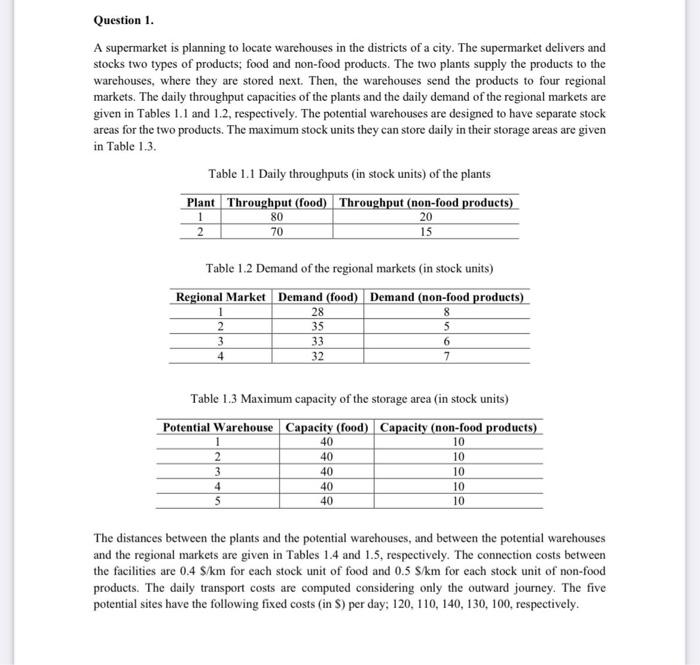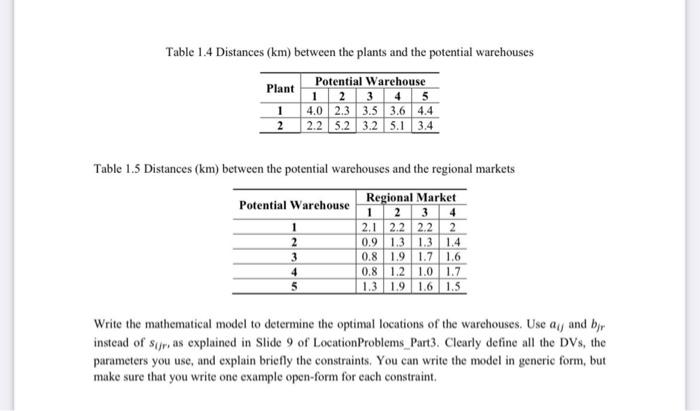A supermarket is planning to locate warehouses in the districts of a city. The supermarket delivers and stocks two types of products; food and non-food products. The two plants supply the products to the warehouses, where they are stored next. Then, the warehouses send the products to four regional markets. The daily throughput capacities of the plants and the daily demand of the regional markets are given in Tables 1.1 and 1.2, respectively. The potential warehouses are designed to have separate stock areas for the two products. The maximum stock units they can store daily in their storage areas are given in Table 1.3. Table 1.1 Daily throughputs (in stock units) of the plants Table 1.2 Demand of the regional markets (in stock units) Table 1.3 Maximum capacity of the storage area (in stock units) The distances between the plants and the potential warehouses, and between the potential warehouses and the regional markets are given in Tables 1.4 and 1.5 , respectively. The connection costs between the facilities are 0.4S/km for each stock unit of food and 0.5S/km for each stock unit of non-food products. The daily transport costs are computed considering only the outward journey. The five potential sites have the following fixed costs (in \$) per day; 120, 110, 140, 130, 100, respectively. Table 1.4 Distances (km) between the plants and the potential warehouses Table 1.5 Distances (km) between the potential warehouses and the regional markets Write the mathematical model to determine the optimal locations of the warehouses. Use aij and bjr instead of sijr, as explained in Slide 9 of LocationProblems_Part3. Clearly define all the DVs, the parameters you use, and explain briefly the constraints. You can write the model in generic form, but make sure that you write one example open-form for each constraint. A supermarket is planning to locate warehouses in the districts of a city. The supermarket delivers and stocks two types of products; food and non-food products. The two plants supply the products to the warehouses, where they are stored next. Then, the warehouses send the products to four regional markets. The daily throughput capacities of the plants and the daily demand of the regional markets are given in Tables 1.1 and 1.2, respectively. The potential warehouses are designed to have separate stock areas for the two products. The maximum stock units they can store daily in their storage areas are given in Table 1.3. Table 1.1 Daily throughputs (in stock units) of the plants Table 1.2 Demand of the regional markets (in stock units) Table 1.3 Maximum capacity of the storage area (in stock units) The distances between the plants and the potential warehouses, and between the potential warehouses and the regional markets are given in Tables 1.4 and 1.5 , respectively. The connection costs between the facilities are 0.4S/km for each stock unit of food and 0.5S/km for each stock unit of non-food products. The daily transport costs are computed considering only the outward journey. The five potential sites have the following fixed costs (in \$) per day; 120, 110, 140, 130, 100, respectively. Table 1.4 Distances (km) between the plants and the potential warehouses Table 1.5 Distances (km) between the potential warehouses and the regional markets Write the mathematical model to determine the optimal locations of the warehouses. Use aij and bjr instead of sijr, as explained in Slide 9 of LocationProblems_Part3. Clearly define all the DVs, the parameters you use, and explain briefly the constraints. You can write the model in generic form, but make sure that you write one example open-form for each constraint








